OV7670的引脚速率比STM32F103C8T6的引脚速率快很多,所以无法直接通信,需要选择带有FIFO的OV7670模块,我购买的是华强北的带FIFO OV7670模块,连同TFT屏幕连接到单片机上,如图
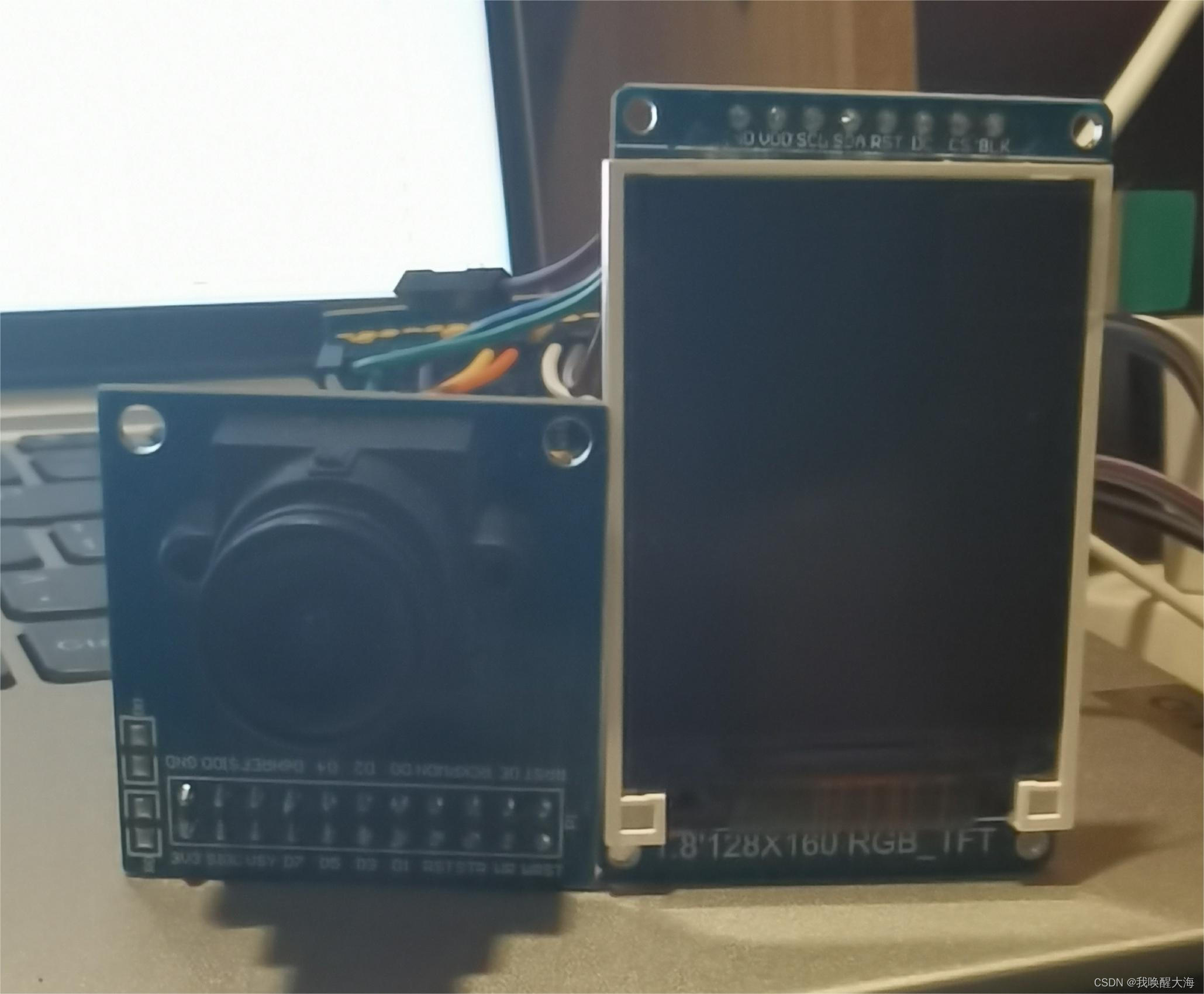
一、在cube上配置单片机引脚
单片机连接摄像头使用了十八个引脚,所以需要配置十六个引脚。单片机和摄像头通过SCCB接口相连接,这里我使用了软件模拟SCCB的方式,十六个引脚可在单片机上自由选择,不过单片机读取摄像头的像素时需要八个相邻的引脚,我选择的是PA0-PA7,接在OV7670的D0-D7上,然后,OV7670的SCL,SDA,WRST和OE引脚,分别接在单片机的PB10,PB11,PB12和PB14引脚,OV7670的WR,RRST,RCLK和VS引脚,接在单片机的PA8,PB0,PA11和PA12引脚,如图
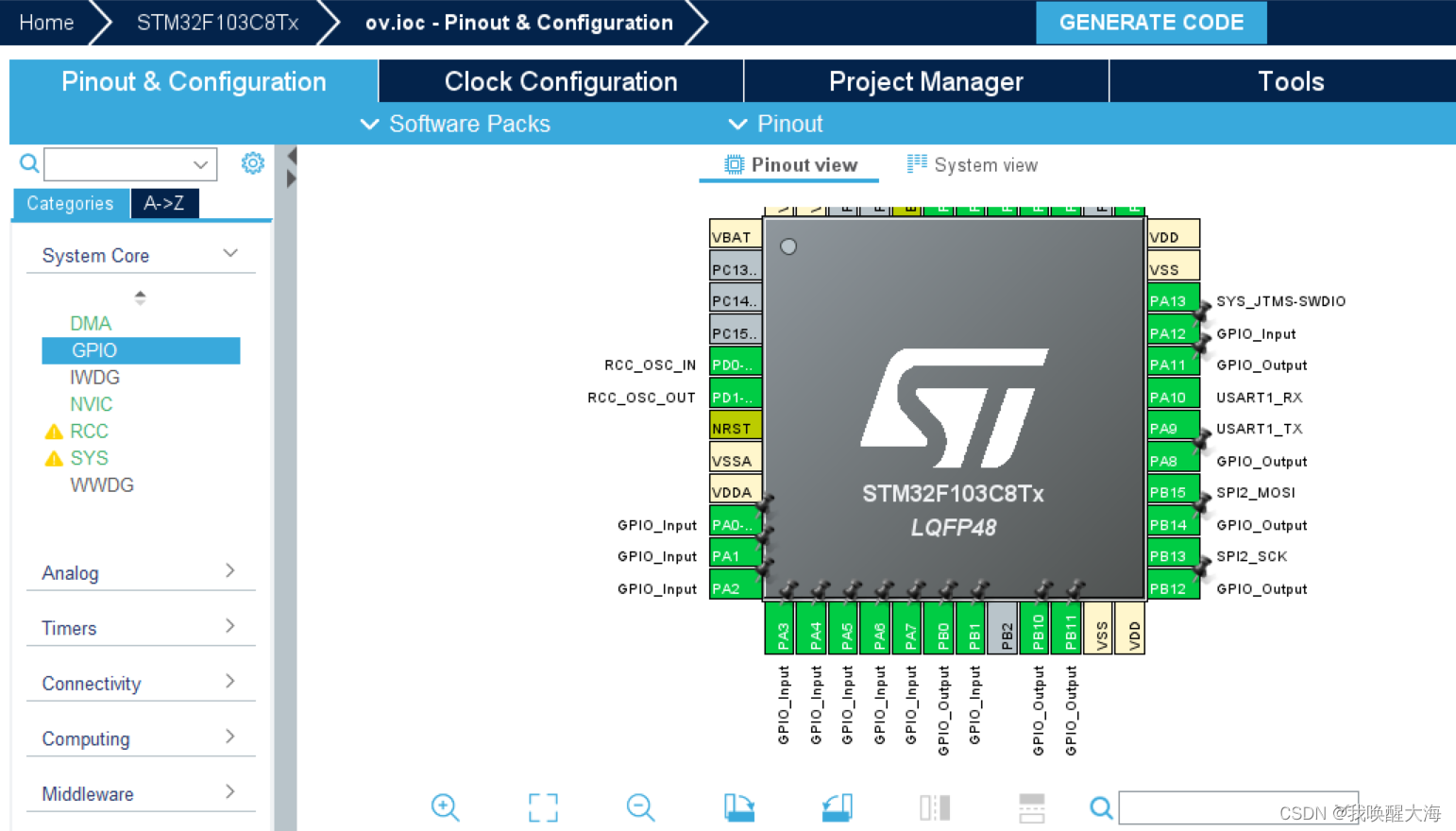
其中,PA0-PA7配置为上拉输入模式,如图
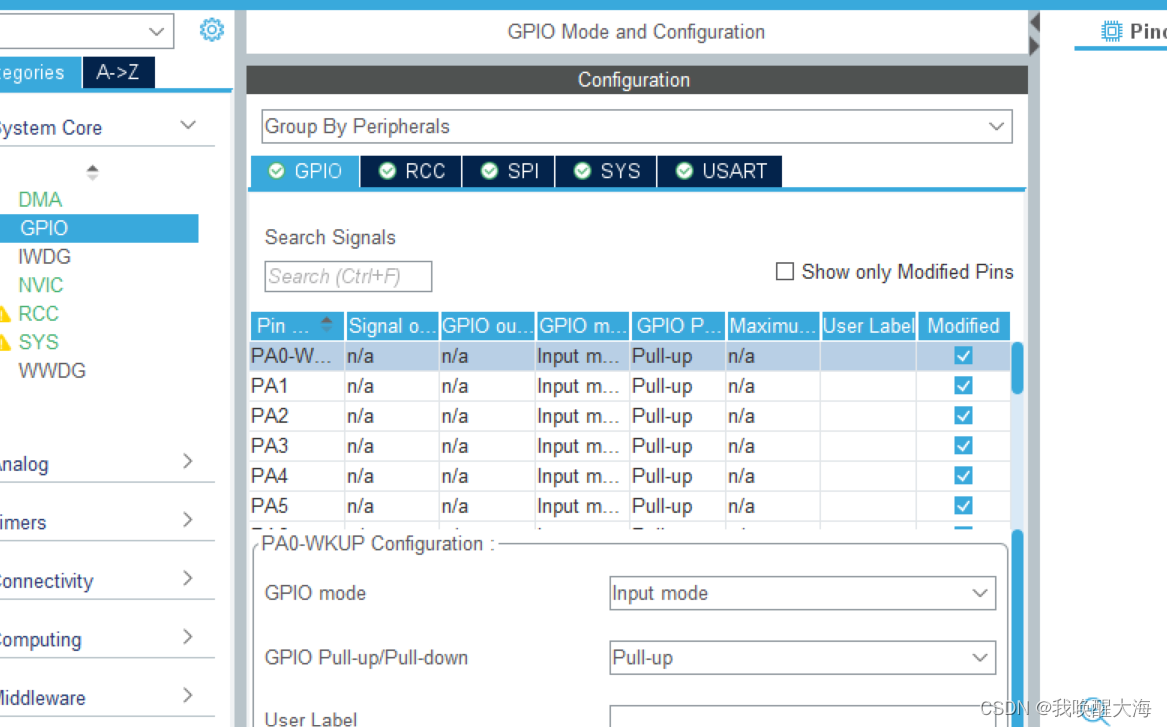
PB10,PB11,PB12和PB14引脚配置为输出模式,引脚速率一定设置为高速,如图
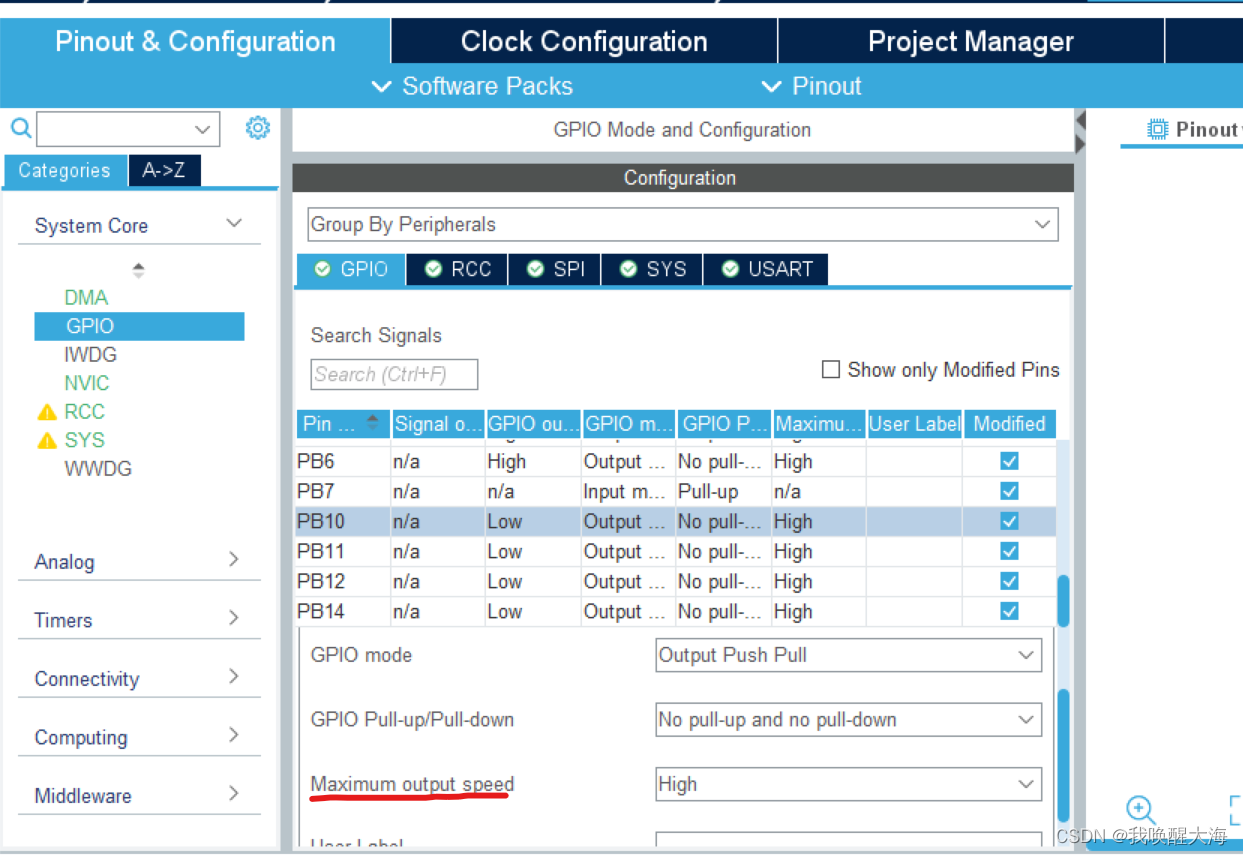
PA8,PB0和PA11引脚配置为输出模式,速率为高速,PA12引脚配置为上拉输入模式,如图
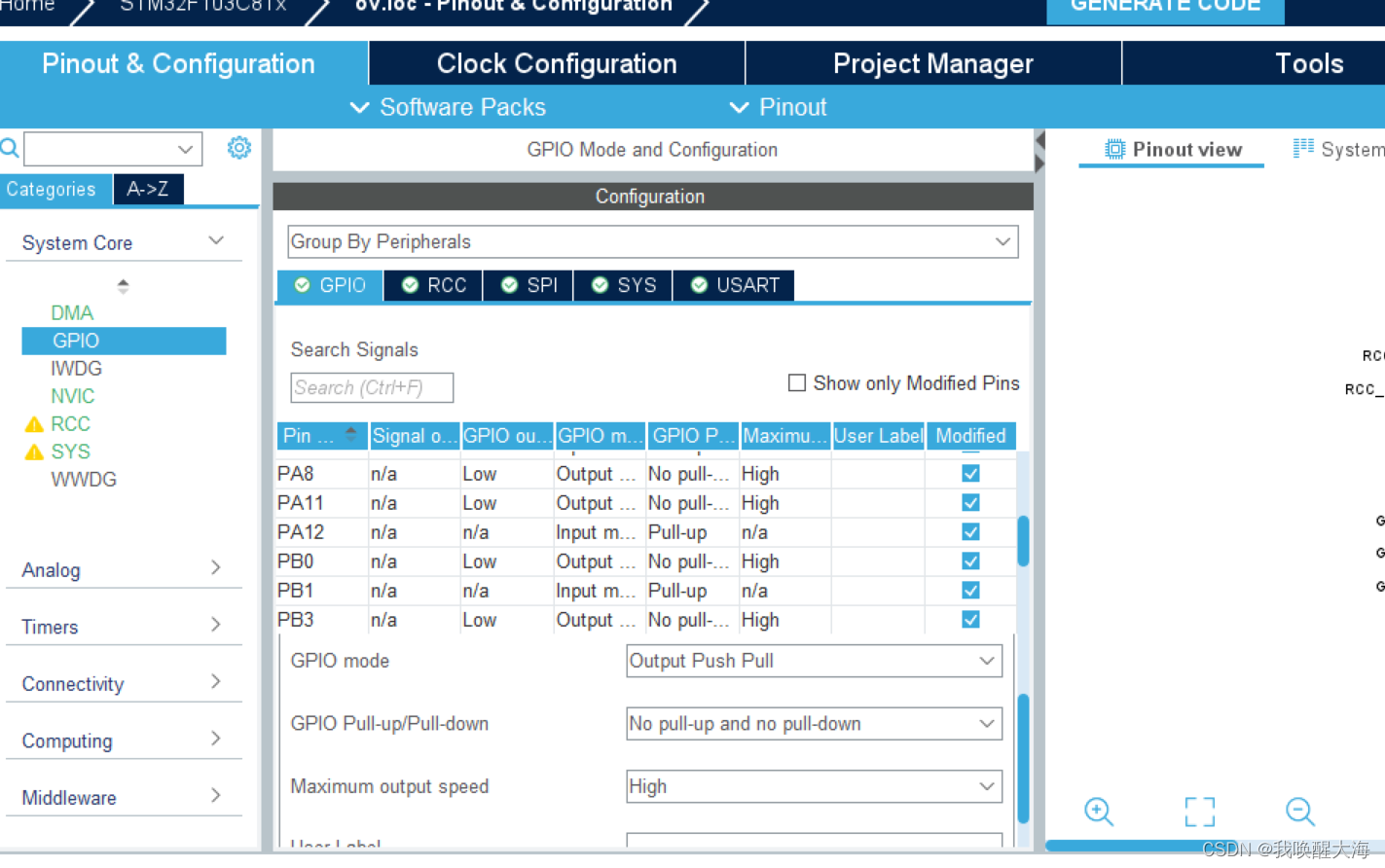
至此引脚就配置好了,生成keil工程。
二、在keil中编写程序
1.模拟SCCB接口
单片机和OV7670的通信通过SCCB接口,也就是PB10和PB11所连接的SCL、SDA引脚,设计到数据的收和发,所以PB11引脚的模式需要在使用过程中变换,分别是上拉输入和输出模式,代码如下
void SCCB_SDA_IN(void)//配置PB11引脚的工作模式
{
GPIO_InitTypeDef GPIO_InitStruct = {0};
GPIO_InitStruct.Pin = GPIO_PIN_11;
GPIO_InitStruct.Mode = GPIO_MODE_INPUT;
GPIO_InitStruct.Speed = GPIO_SPEED_FREQ_HIGH;
GPIO_InitStruct.Pull = GPIO_PULLUP;
HAL_GPIO_Init(GPIOB, &GPIO_InitStruct);
}
void SCCB_SDA_OUT(void)
{
GPIO_InitTypeDef GPIO_InitStruct = {0};
GPIO_InitStruct.Pin = GPIO_PIN_11;
GPIO_InitStruct.Mode = GPIO_MODE_OUTPUT_PP;
GPIO_InitStruct.Pull = GPIO_NOPULL;
GPIO_InitStruct.Speed = GPIO_SPEED_FREQ_HIGH;
HAL_GPIO_Init(GPIOB, &GPIO_InitStruct);
HAL_GPIO_WritePin(GPIOB,GPIO_PIN_11,1);
}下面是SCCB接口在软件模拟时用到的基础函数,需要注意的是微秒级的延时,写成毫秒是会出错的。
void SCCB_Start(void)
{
SCCB_SDA_OUT();
SCCB_W_SDA(1);
SCCB_W_SCL(1);
Delay_us(50);
SCCB_W_SDA(0);
Delay_us(50);
SCCB_W_SCL(0);
Delay_us(50);
}
void SCCB_Stop(void)
{
SCCB_SDA_OUT();
SCCB_W_SDA(0);
Delay_us(50);
SCCB_W_SCL(1);
Delay_us(50);
SCCB_W_SDA(1);
Delay_us(50);
}
uint8_t SCCB_SendByte(uint8_t Byte)
{
uint8_t i,res = 0;
SCCB_SDA_OUT();
for (i = 0; i < 8; i ++)
{
if((Byte << i) & 0x80)
{
SCCB_W_SDA(1);
}
else
{
SCCB_W_SDA(0);
}
Delay_us(50);
SCCB_W_SCL(1);
Delay_us(50);
SCCB_W_SCL(0);
}
SCCB_SDA_IN();
Delay_us(50);
SCCB_W_SCL(1);
Delay_us(50);
if(SCCB_R_SDA())res = 1;
else res = 0;
SCCB_W_SCL(0);
return res;
}
uint8_t SCCB_ReceiveByte(void)
{
uint8_t i, Byte = 0x00;
SCCB_SDA_IN();
for (i = 0; i < 8; i ++)
{
Delay_us(50);
SCCB_W_SCL(1);
Byte = Byte << 1;
if (SCCB_R_SDA()){Byte ++;}
Delay_us(50);
SCCB_W_SCL(0);
}
return Byte;
}
void SCCB_SendNA()
{
SCCB_SDA_OUT();
Delay_us(50);
SCCB_W_SDA(1);
SCCB_W_SCL(1);
Delay_us(50);
SCCB_W_SCL(0);
Delay_us(50);
SCCB_W_SDA(0);
Delay_us(50);
}
uint8_t SCCB_ReceiveAck(void)
{
uint8_t AckBit;
SCCB_SDA_IN();
SCCB_W_SCL(0);
Delay_us(100);
SCCB_W_SCL(1);
Delay_us(100);
AckBit = SCCB_R_SDA();
SCCB_W_SCL(0);
Delay_us(100);
SCCB_SDA_OUT();
return AckBit;
}我所用的微秒级延时函数如下
#define AHB_freq 72000000UL
void Delay_us(uint32_t us)
{
us = (1<<25) <= us ? (1<<25) - 1 : us;
SysTick->LOAD = us * (AHB_freq / 8000000);
SysTick->VAL = 0;
SysTick->CTRL = 0x01;
while(!(SysTick->CTRL & SysTick_CTRL_COUNTFLAG_Msk));
SysTick->CTRL &= ~(0x01<<SysTick_CTRL_ENABLE_Pos);
}2.通过模拟的SCCB接口和OV7670通信,并初始化OV7670的寄存器
首先是对OV7670寄存器的读写操作函数
uint8_t OV7670_WriteReg(uint8_t RegAddress, uint8_t Data)//可写为void类型
{
uint8_t res=0;
SCCB_Start();
if(SCCB_SendByte(0X42))res = 1;
Delay_us(100);
if(SCCB_SendByte(RegAddress))res = 1;
Delay_us(100);
if(SCCB_SendByte(Data)) res = 1;
Delay_us(100);
SCCB_Stop();
return res;
}
uint8_t OV7670_ReadReg(uint8_t RegAddress)
{
uint8_t Data,a = 0;
SCCB_Start();
SCCB_SendByte(0x42);
Delay_us(100);
SCCB_SendByte(RegAddress);
Delay_us(100);
SCCB_Stop();
Delay_us(100);
SCCB_Start();
SCCB_SendByte(0x43);
Delay_us(100);
Data = SCCB_ReceiveByte();
SCCB_SendNA();
SCCB_Stop();
return Data;
}我记得当时可以直接读取OV7670的0X0A、0X0B寄存器,这是它的ID号,读出来的结果是0X76、0X73,可以通过这两个数据判断模拟SCCB接口的函数写的是否正确,调用上面的OV7670_ReadReg函数,大概长这样
void transmit(uint8_t a)//发送到串口显示
{
HAL_UART_Transmit(&huart1,&a,1,5);
}
uint8_t ac=0;
ac = OV7670_ReadReg(0x0a);//写在主函数里
transmit(ac);
ac = OV7670_ReadReg(0x0b);
transmit(ac);如果串口收到的数据是76和73,代表可以通信了,下面开始配置OV7670的寄存器,寄存器初始化的数据是可变的,不是一个固定的数组,在配置的有错误时,会出现花屏的现象,以下是我用的初始数组和配置函数,设置图片清晰度的函数是我在网上找的
const uint8_t OV7670_Reg[166][2]=
{
{0x3a, 0x04},
{0x40, 0x10},
{0x12, 0x14},
{0x32, 0x80},
{0x17, 0x17},
{0x18, 0x05},
{0x19, 0x02},
{0x1a, 0x7b},//0x7a,
{0x03, 0x0a},//0x0a,
{0x0c, 0x0c},
{0x3e, 0x00},
{0x70, 0x00},
{0x71, 0x01},
{0x72, 0x11},
{0x73, 0x09},
{0xa2, 0x02},
{0x11, 0x00},
{0x7a, 0x20},
{0x7b, 0x1c},
{0x7c, 0x28},
{0x7d, 0x3c},
{0x7e, 0x55},
{0x7f, 0x68},
{0x80, 0x76},
{0x81, 0x80},
{0x82, 0x88},
{0x83, 0x8f},
{0x84, 0x96},
{0x85, 0xa3},
{0x86, 0xaf},
{0x87, 0xc4},
{0x88, 0xd7},
{0x89, 0xe8},
{0x13, 0xe0},
{0x00, 0x00},
{0x10, 0x00},
{0x0d, 0x00},//窗口
{0x14, 0x38},
{0xa5, 0x05},
{0xab, 0x07},
{0x24, 0x75},
{0x25, 0x63},
{0x26, 0xA5},
{0x9f, 0x78},
{0xa0, 0x68},
{0xa1, 0x03},//0x0b,
{0xa6, 0xdf},//0xd8,
{0xa7, 0xdf},//0xd8,
{0xa8, 0xf0},
{0xa9, 0x90},
{0xaa, 0x94},
{0x13, 0xe5},
{0x0e, 0x61},
{0x0f, 0x4b},
{0x16, 0x02},
{0x1e, 0x07},//0x07,0x27
{0x21, 0x02},
{0x22, 0x91},
{0x29, 0x07},
{0x33, 0x0b},
{0x35, 0x0b},
{0x37, 0x1d},
{0x38, 0x71},
{0x39, 0x2a},
{0x3c, 0x78},
{0x4d, 0x40},
{0x4e, 0x20},
{0x69, 0x5d},
{0x6b, 0x40},//PLL
{0x74, 0x19},
{0x8d, 0x4f},
{0x8e, 0x00},
{0x8f, 0x00},
{0x90, 0x00},
{0x91, 0x00},
{0x92, 0x00},//0x19,//0x66
{0x96, 0x00},
{0x9a, 0x80},
{0xb0, 0x84},
{0xb1, 0x0c},
{0xb2, 0x0e},
{0xb3, 0x82},
{0xb8, 0x0a},
{0x43, 0x14},
{0x44, 0xf0},
{0x45, 0x34},
{0x46, 0x58},
{0x47, 0x28},
{0x48, 0x3a},
{0x59, 0x88},
{0x5a, 0x88},
{0x5b, 0x44},
{0x5c, 0x67},
{0x5d, 0x49},
{0x5e, 0x0e},
{0x64, 0x04},
{0x65, 0x20},
{0x66, 0x05},
{0x94, 0x04},
{0x95, 0x08},
{0x6c, 0x0a},
{0x6d, 0x55},
{0x6e, 0x11},
{0x6f, 0x9f},
{0x6a, 0x40},
{0x13, 0xe7},
{0x15, 0x00},
{0x4f, 0x80},
{0x50, 0x80},
{0x51, 0x00},
{0x52, 0x22},
{0x53, 0x5e},
{0x54, 0x80},
{0x55, 0x00},
{0x56, 0x60},
{0x57, 0x90},
{0x58, 0x9e},
{0x41, 0x08},
{0x3f, 0x05},
{0x75, 0x05},
{0x76, 0xe1},
{0x4c, 0x0F},
{0x77, 0x0a},
{0x3d, 0xc2}, //0xc0,
{0x4b, 0x09},
{0xc9, 0xc8},
{0x41, 0x38},
{0x34, 0x11},
{0x3b, 0x02},//0x00,//0x02,
{0xa4, 0x89},//0x88,
{0x96, 0x00},
{0x97, 0x30},
{0x98, 0x20},
{0x99, 0x30},
{0x9a, 0x84},
{0x9b, 0x29},
{0x9c, 0x03},
{0x9d, 0x4c},
{0x9e, 0x3f},
{0x78, 0x04},
{0x79, 0x01},
{0xc8, 0xf0},
{0x79, 0x0f},
{0xc8, 0x00},
{0x79, 0x10},
{0xc8, 0x7e},
{0x79, 0x0a},
{0xc8, 0x80},
{0x79, 0x0b},
{0xc8, 0x01},
{0x79, 0x0c},
{0xc8, 0x0f},
{0x79, 0x0d},
{0xc8, 0x20},
{0x79, 0x09},
{0xc8, 0x80},
{0x79, 0x02},
{0xc8, 0xc0},
{0x79, 0x03},
{0xc8, 0x40},
{0x79, 0x05},
{0xc8, 0x30},
{0x69, 0xaa},
{0x09, 0x00},
{0x3b, 0x42},
{0x2d, 0x01}
};
void OV7670_config_window(unsigned int startx,unsigned int starty,unsigned int width, unsigned int height)
{
unsigned int endx;
unsigned int endy;
unsigned char temp_reg1, temp_reg2;
unsigned char temp=0;
endx=(startx+width*2)%784;
endy=(starty+height+height);
temp_reg1 = OV7670_ReadReg(0x03);
temp_reg1 &= 0xf0;
temp_reg2 = OV7670_ReadReg(0x32);
temp_reg2 &= 0xc0;
// Horizontal
temp = temp_reg2|((endx&0x7)<<3)|(startx&0x7);
OV7670_WriteReg(0x32, temp );
temp = (startx&0x7F8)>>3;
OV7670_WriteReg(0x17, temp );
temp = (endx&0x7F8)>>3;
OV7670_WriteReg(0x18, temp );
// Vertical
temp =temp_reg1|((endy&0x3)<<2)|(starty&0x3);
OV7670_WriteReg(0x03, temp );
temp = (starty & 0x3fc)>>2;
OV7670_WriteReg(0x19, temp );
temp = (endy & 0x3fc)>>2;
OV7670_WriteReg(0x1A, temp );
}
void OV7670_Configure(void)
{
uint8_t i;
OV7670_WriteReg(0x12,0x80);
Delay_us(100000);
for(i=0;i<166;i++)
{
OV7670_WriteReg(OV7670_Reg[i][0],OV7670_Reg[i][1]);
}
OV7670_config_window(184,10,128,160);//配置OV7670输出图片的清晰度为128*160
//OV7670_config_window(184,10,80,160);
}
然后是对除SDA、SCL引脚外的六个引脚的读取或赋值函数
uint8_t OV7670_VS(void)
{
return HAL_GPIO_ReadPin(GPIOA,GPIO_PIN_12);
}
void OV7670_W_RRST(uint8_t BitValue)
{
HAL_GPIO_WritePin(GPIOB, GPIO_PIN_0, BitValue);
Delay_us(10);
}
void OV7670_W_WRST(uint8_t BitValue)
{
HAL_GPIO_WritePin(GPIOB, GPIO_PIN_12, BitValue);
Delay_us(10);
}
void OV7670_W_WEN(uint8_t BitValue)
{
HAL_GPIO_WritePin(GPIOA, GPIO_PIN_8, BitValue);
Delay_us(10);
}
void OV7670_W_OE(uint8_t BitValue)
{
HAL_GPIO_WritePin(GPIOB, GPIO_PIN_14, BitValue);
Delay_us(10);
}
void OV7670_W_RCLK(uint8_t BitValue)
{
HAL_GPIO_WritePin(GPIOA, GPIO_PIN_11, BitValue);
Delay_us(10);
}3.将OV7670的图片读取并显示在1.8寸TFT屏幕上
如果对OV7670寄存器的配置基本正确的话,可以开始显示图片了,首先可以配置寄存器0X70、0X71为0X3A、0XB5,让OV7670输出八色彩条,检查图片颜色的对错,具体为
uint8_t value1 = 0,value2 = 0;
uint16_t w,h,color;
void ov7670()//单片机读取OV7670的图片像素并发送到TFT屏幕上
{
while(OV7670_VS()==0){};
OV7670_W_WRST(0);
OV7670_W_WRST(1);
OV7670_W_WEN(1);
Delay_us(40000);
while(OV7670_VS()==0);
OV7670_W_WRST(0);
OV7670_W_WRST(1);
OV7670_W_WEN(0);
Delay_us(50000);
OV7670_W_OE(0);
OV7670_W_RRST(0);
OV7670_W_RCLK(0);
Delay_us(20000);
OV7670_W_RCLK(1);
Delay_us(20000);
OV7670_W_RCLK(0);
Delay_us(20000);
OV7670_W_RRST(1);
Delay_us(20000);
OV7670_W_RCLK(1);
set_windows(0,0,lcddev.width-1,lcddev.height-1);
for(h=0;h<160;h++)//128
{
for(w=0;w<128;w++)
{
OV7670_W_RCLK(0);
value1 = (uint8_t)GPIOA->IDR & 0xff;
OV7670_W_RCLK(1);
OV7670_W_RCLK(0);
value2 = (uint8_t)GPIOA->IDR & 0xff;
OV7670_W_RCLK(1);
color = (value1 << 8) | value2;
TFT_WRITE_u16_DATA(color);
}
}
OV7670_W_OE(1);
}
//写在主函数里
OV7670_WriteReg(0x70, 0x3A);//输出八色彩条,不调用则输出摄像头拍摄到的图像
OV7670_WriteReg(0x71, 0xB5);
tft_init();
lcd_clear((uint16_t)WHITE);
while(1)
{
Delay_us(1000000);
ov7670();
}
如果在屏幕上看到了八色彩条,可以注释掉对0X70、0X71寄存器配置的函数,之后可以看到摄像头拍摄到的图像。





















 3984
3984

 被折叠的 条评论
为什么被折叠?
被折叠的 条评论
为什么被折叠?








